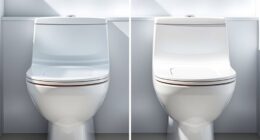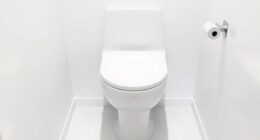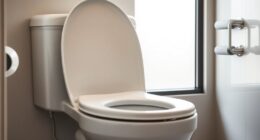We’ve all faced the dilemma of finding a toilet that won’t fill with water, causing us to feel irritated and desperate for a fix. If you keep reading, you’ll discover some surprising tips on how to tackle this common issue.
In this article, we will explore the common causes of this issue and provide step-by-step directions on how to troubleshoot and fix it.
From checking the water supply line to replacing a faulty float, we’ll help you regain control of your toilet’s water flow.
Get ready to master the art of toilet repair!

Key Takeaways
- A clogged fill valve or mineral buildup can restrict water flow into the toilet tank.
- Evaluating water pressure and ensuring the shut off valve is fully open are important in diagnosing the issue.
- Adjusting the fill valve and troubleshooting for sediment buildup can resolve the problem.
- Cleaning the fill tube and replacing a faulty toilet float are also potential solutions for a toilet not filling with water.
Common Causes of Toilet Water Not Filling
One common cause of a toilet not filling with water is a clogged fill valve. The fill valve is responsible for regulating the water flow into the toilet tank. If it becomes clogged, it can restrict the water flow, preventing the tank from filling properly. Understanding the role of water pressure in toilet filling is crucial in diagnosing this issue.
Another factor that can affect the fill mechanism is hard water. Hard water contains minerals that can accumulate in the fill valve and other parts of the toilet, hindering their functionality. To resolve this issue, it’s essential to clean or replace the fill valve.
In the next section, we’ll explore another possible cause for a toilet not filling with water: checking the water supply line.
Checking the Water Supply Line
Continuing from the previous subtopic, we can address the issue of a toilet not filling with water by checking the water supply line. Evaluating water pressure and inspecting the shut off valve are two key steps to take in diagnosing the problem.

Firstly, evaluating water pressure is crucial. Low water pressure can prevent the toilet tank from filling properly. To evaluate the water pressure, turn on another faucet in the house and see if the water flow is strong. If the water pressure is low throughout the house, the issue may lie with the main water supply.
Secondly, inspecting the shut off valve is important. Ensure that the shut off valve, usually located behind the toilet, is fully open. Sometimes, the valve may be partially closed, restricting water flow to the toilet tank.
Troubleshooting the Fill Valve
To troubleshoot the fill valve, we’ll now address the steps necessary to ensure proper functioning and water flow in the toilet tank.
Firstly, check the fill valve height adjustment. If the water level in the tank is too low, the fill valve may need to be adjusted. Locate the adjustment screw on the fill valve and turn it clockwise to raise the water level or counterclockwise to lower it.

Secondly, sediment buildup in the fill valve can obstruct water flow. To clean the fill valve, turn off the water supply to the toilet and flush to drain the tank. Remove the fill valve cap and rinse it under running water to remove any sediment. Reassemble the fill valve and turn the water supply back on.
Now, let’s move on to fixing a clogged toilet fill tube, which may also cause problems with water flow.
Fixing a Clogged Toilet Fill Tube
Now let’s address how we can fix a clogged toilet fill tube to ensure proper water flow in the tank.
When the toilet fill tube is clogged, it can prevent water from entering the tank, causing the toilet not to fill properly. To unclog the toilet fill tube, follow these steps:

- First, turn off the water supply to the toilet by closing the shut-off valve.
- Next, detach the fill tube from the fill valve by unscrewing the nut that connects them.
- Use a small brush or pipe cleaner to remove any debris or mineral deposits from the fill tube. Make sure to clean both ends thoroughly.
- Reattach the fill tube to the fill valve, making sure it’s securely fastened.
- Turn on the water supply and check if the toilet is filling properly now.
Regularly cleaning the toilet tank and using appropriate toilet tank cleaning methods can help prevent clogs in the fill tube. By following these steps, you can ensure proper water flow and maintain a fully functional toilet.
Replacing a Faulty Toilet Float
After addressing the issue of a clogged toilet fill tube, let’s now focus on replacing a faulty toilet float. The toilet float is responsible for regulating the water level in the tank, and if it malfunctions, it can prevent the tank from filling properly. Before replacing the float, it is important to shut off the water supply to the toilet and drain the tank completely. Once the tank is empty, the defective float can be detached and a new one can be installed. To ensure proper functioning, it is also recommended to clean the toilet tank and adjust the water pressure if needed. Here is a table summarizing the steps to replace a faulty toilet float:
| Steps |
|---|
| 1. Shut off the water supply |
| 2. Drain the tank |
| 3. Detach the faulty float |
| 4. Install the new float |
| 5. Clean the toilet tank |
Frequently Asked Questions
How Can I Fix a Toilet That Is Not Filling With Water if None of the Common Causes Mentioned in the Article Apply to My Situation?
If none of the common causes mentioned in the article apply, we recommend troubleshooting the toilet water fill issue by considering a toilet fill valve replacement. This can often resolve the problem.
What Should I Do if the Water Supply Line Seems Fine, but the Toilet Is Still Not Filling With Water?
If the water supply line seems fine but the toilet still isn’t filling, there could be several reasons. First, check the float valve and adjust it if necessary. If that doesn’t work, you might need to replace the fill valve.

Are There Any Temporary Solutions I Can Try Before Replacing the Fill Valve?
Before replacing the fill valve, we can try temporary fixes or alternative solutions. These may include checking the water supply line for blockages, adjusting the float level, or cleaning the fill valve.
How Can I Determine if the Toilet Fill Tube Is Clogged and Causing the Water Not to Fill?
To determine if the toilet fill tube is clogged, we can inspect it for any obstructions. By disconnecting the tube and checking for debris or mineral buildup, we can identify the cause of the water not filling.
Can I Replace the Faulty Toilet Float Myself, or Should I Hire a Professional Plumber for This Task?
We can replace the faulty toilet float ourselves, but it’s recommended to hire a professional plumber for this task. They have the expertise and tools to ensure a proper installation and avoid any potential issues.
Conclusion
So there you have it, folks. Your toilet isn’t filling with water, and we’ve given you all the technical, concise, and informative steps to troubleshoot and fix the issue.

Now you can become your own personal plumber and save yourself some cash. Just remember, when it comes to toilets, water is key.
And if all else fails, maybe it’s time to invest in a fancy bidet.
Happy plumbing!










